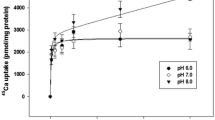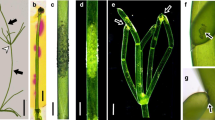Summary
The light-mediated, time-dependent rise in the pH value at the center of an alkaline band was analyzed using the methods of numerical analysis. From this analysis an expression of the time-dependent build-up of OH− efflux was obtained for these bands. This information can now be employed to determine whether the light-activated transport of OH− and HCO −3 influences the electrical properties of the plasmalemma. The dark-induced deactivation of OH− transport was also characterized, revealing a transition from efflux to a transient influx phase during deactivation.
Numerical analysis of the steady-state OH− diffusion pattern, established along the surface of an alkaline band, revealed that the OH− efflux width was wider than previously envisaged. It was also found that OH− sink regions exist on either side of the efflux zone. These, and other characteristics revealed by the numerical analysis, enabled us to extend the OH− transport model proposed by Lucas (J. Exp. Bot. 1975,26:347).
Similar content being viewed by others
References
Hope, A.B. 1965. Ionic relations of cells ofChara australis. X. Effects of bicarbonate ions on electrical properties.Aust. J. Biol. Sci. 18:789
Kitasato, H. 1968. The influence of H+ on the membrane potential and ion fluxes ofNitella.J. Gen. Physiol. 52:60
Lucas, W.J. 1975a. Analysis of the diffusion symmetry developed by the alkaline and acid bands which form at the surface ofChara corallina cells.J. Exp. Bot. 26:271
Lucas, W.J. 1975b. Photosynthetic fixation of14carbon by internodal cells ofChara corallina.J. Exp. Bot. 26:331
Lucas, W.J. 1975c. The influence of light intensity on the activation and operation of the hydroxyl efflux system ofChara corallina.J. Exp. Bot. 26:347
Lucas, W.J. 1975d. Ionic relations ofChara corallina: Studies on transport of HCO −3 , OH− and H+ across the plasma membrane. Ph.D. Thesis. University of Adelaide, South Australia
Lucas, W.J. 1976. Plasmalemma transport of HCO −3 and OH− inChara corallina: Nonantiporter systems.J. Exp. Bot. 27:19
Lucas, W.J., Dainty, J. 1977. Spatial distribution of functional OH− carriers along a Characean internodal cell: Determined by the effect of cytochalasin B on H14CO −3 assimilation.J. Membrane Biol. 32:75
Lucas, W.J., Smith, F.A. 1973. The formation of alkaline and acid regions at the surface ofChara corallina cells.J. Exp. Bot. 24:1
Lucas, W.J., Smith, F.A. 1976. Influence of irradiance on H+ efflux and Cl− influx inChara corallina: An investigation aimed at testing two Cl− transport models.Aust. J. Plant Physiol. 3:1
Nishizaki, Y. 1968. Light-induced changes of bioelectric potentials inChara.Plant Cell Physiol. 9:377
Onsager, L. 1945. Theory and problems of liquid diffusion.Ann. N.Y. Acad. Sci. 46:241
Richards, J.L., Hope, A.B. 1974. The role of protons in determining membrane electrical characteristics inChara corallina.J. Membrane Biol. 16:121
Robinson, R.A., Stokes, R.H. 1965. Electrolyte Solutions. Second edition, Butterworths, London
Saito, K., Senda, M. 1973. The light-dependent effect of external pH on the membrane potential ofNitella.Plant Cell Physiol. 14:147
Saito, K., Senda, M. 1974. The electrogenic ion pump revealed by the external pH effect on the membrane potential ofNitella. Influences of external ions and electric current on the pH effect.Plant Cell Physiol. 15:1007
Sirs, J.A. 1958. Electrometric stopped flow measurements of rapid reactions in solution: Part 2. Glass electrode pH measurements.Trans. Faraday Soc. 54:207
Smith, F.A. 1970. The mechanism of chloride transport in Characean cells.New Phytol. 69:903
Spanswick, R.M. 1972. Evidence for an electrogenic ion pump inNitella translucens. I. The effects of pH, K+, Na+, light and temperature on the membrane potential and resistance.Biochim. Biophys. Acta 288:73
Spanswick, R.M. 1974. Evidence for an electrogenic ion pump inNitella translucens. II. Control of the light-stimulated component of the membrane potential.Biochim. Biophys. Acta 332:387
Spear, D.G., Barr, J.K., Barr, C.E. 1969. Localization of hydrogen ion and chloride ion fluxes inNitella.J. Gen. Physiol. 54:397
Volkov, G.A. 1973. Bioelectrical response of theNitella flexilis cell to illumination: A new possible state of plasmalemma in a plant cell.Biochim. Biophys. Acta 314:83
Walker, N.A. 1962. Effect of light on the plasmalemma ofChara cells.Annu. Rep. Div. Plant Ind. C.S.I.R.O., p. 80
Author information
Authors and Affiliations
Rights and permissions
About this article
Cite this article
Lucas, W.J., Ferrier, J.M. & Dainty, J. Plasmalemma transport of OH− inChara corallina . J. Membrain Biol. 32, 49–73 (1977). https://doi.org/10.1007/BF01905209
Received:
Revised:
Issue Date:
DOI: https://doi.org/10.1007/BF01905209




